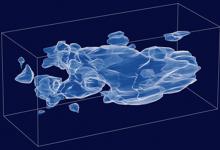Science & Nature
Red-breasted Merganser
Undoubtedly one of Ireland's most flamboyant-looking birds, the Red-breasted Merganser is a member of the duck family. Breeding is confined mainly to coastal lakes and rivers in the west and north of the island, often in areas with good woodland cover. In the winter, however, when our resident population is augmented by migrants from northern Europe, they can be seen at estuaries, sea inlets and sheltered bays right around the coast, though not often in terribly large numbers.
Nature: Buried in the sand
The riddle of the wormlike coils of sand on the beach is solved by Éanna Ní Lamhna, but there are plenty more mysteries about the lugworm
Turnstone (Piardálaí trá, Arenaria interpres)
A small (23cm), distinctively-marked wader, the Turnstone is a common sight all around the Irish coast. Although found here throughout the year, the species does not breed in Ireland; most seen here visit only for the winter, though many youngsters in their first year, not yet of breeding age, choose to remain for the summer too. Very much associated with rocky shores, especially those with an abundance of seaweed, they are also frequently encountered on shingle beaches, estuarine mudflats and piers, where they can appear quite tame and tolerant of people and dogs.
Life on Saturn
Saturn's small moon Enceladus (seen here to scale) is one of the most exciting places in the Solar System to astronomers who are searching for life beyond our own Earth. The discovery of geysers near the moon's south pole (inset) was totally unexpected and represents one of the many early triumphs of the US/European mission called Cassini/Huygens.
Practicality in your pocket
New Year reflections
Meditating on the past year's walking, I am in pensive mood like the essayist Charles Lamb.
A warm welcome
The one advantage to global warming is that we get to enjoy a wider variety of wildlife species in our milder winters. Get out and see the lovely Little Egret, says Éanna Ní Lamhna
The Ship Rat (Rattus rattus)
The Ship Rat evolved in the tropical forests of Asia and likes a similar habitat here. It thrives in warm houses, hence its alternative name, the roof rat. It climbs well and eats fruit when it comes accross it, but it will consume almost anything.
The dark side of the Moon
Leo Enright on the first in a series of European Space Agency (ESA) town hall meetings early next month to discuss European involvement in America's plan to establish a permanent human outpost near the south pole of the Moon.


